




Keeping your kitchen floor clean and tidy is essential for maintaining a hygienic and pleasant cooking environment. And when it comes to cleaning tiled floors, you need to know the right techniques and products to ensure a sparkling and germ-free finish. In this article, we will walk you through some easy and effective tips on how to clean a tiled kitchen floor.
1. Sweep or vacuum the floor: Before you start cleaning your tiled kitchen floor, it’s important to remove any loose dirt and debris. Use a broom or vacuum cleaner to sweep away crumbs, dust, and other particles. This will prevent them from getting stuck in the cleaning solution and scratching the tiles.
2. Prepare a cleaning solution: Next, you need to make a cleaning solution that is suitable for your tiled floor. Dilute a mild detergent or tile cleaner in warm water, following the instructions on the product label. Avoid using harsh chemicals or abrasive cleaners that can damage the tiles.
3. Mop the floor: Once you have prepared your cleaning solution, dampen a mop or microfiber cloth with the solution and start mopping the tiled floor. Work in small sections, moving the mop in a gentle circular motion. This will help to lift dirt and stains without causing any damage to the tiles.
4. Pay attention to grout lines: The grout lines between the tiles can easily accumulate dirt and grime. To clean the grout, you can use an old toothbrush or a grout brush. Dip the brush in the cleaning solution and scrub the grout lines gently. Rinse the brush frequently to avoid spreading dirt around.
Pro tip: For stubborn stains or deep cleaning, you can make a paste of baking soda and water. Apply the paste to the stained areas, let it sit for a few minutes, then scrub with a brush and rinse thoroughly.
5. Rinse and dry the floor: After you have finished mopping and scrubbing, rinse the floor with clean water to remove any remaining residue. Make sure to wring out the mop or cloth well to avoid leaving excess water on the floor. Allow the tiles to air dry or use a clean towel to speed up the drying process.
By following these easy and effective tips, you can keep your tiled kitchen floor looking spotless and well-maintained. Remember to regularly clean and maintain your floor to prevent dirt buildup and prolong its lifespan. Happy cleaning!
Effective Cleaning Tips for Tiled Kitchen Floors
Keeping your tiled kitchen floors clean is essential for maintaining a hygienic and beautiful kitchen. Here are some effective tips to help you clean your tiled kitchen floors:
1. Sweep or Vacuum Regularly
Before starting the cleaning process, remove any loose dirt and debris from the floor by sweeping or vacuuming. This will prevent the dirt from scratching the tiles and make the cleaning process easier.
2. Use a Mild Cleaning Solution
For regular cleaning, mix a mild cleaning solution using warm water and a few drops of dish soap or tile cleaner. Avoid using harsh chemicals that can damage the tiles in the long run. Test the solution on a small, inconspicuous area first to ensure it doesn’t cause any discoloration.
3. Mop the Floor
Using a clean mop or microfiber cloth, dip it into the cleaning solution and wring out any excess liquid. Start mopping the floor, working in small sections. Rinse the mop or cloth frequently to avoid spreading dirt around. Be sure to thoroughly remove any soapy residue to prevent a slippery surface.
4. Address Stains and Spills Immediately
If you notice any stains or spills on your tiled kitchen floor, it’s crucial to tackle them immediately. Use a soft cloth or sponge to gently blot the stain, avoiding any scrubbing motions that could damage the tiles. For tougher stains, you can apply a mixture of baking soda and water, let it sit for a few minutes, and then gently scrub the area with a soft brush.
5. Take Extra Care with Grout Lines
The grout lines between the tiles can accumulate dirt and grime over time. To clean the grout, create a paste using baking soda and water. Apply the paste to the grout lines and use a small brush or toothbrush to scrub gently. Rinse the area thoroughly to remove any residue.
6. Dry the Floor
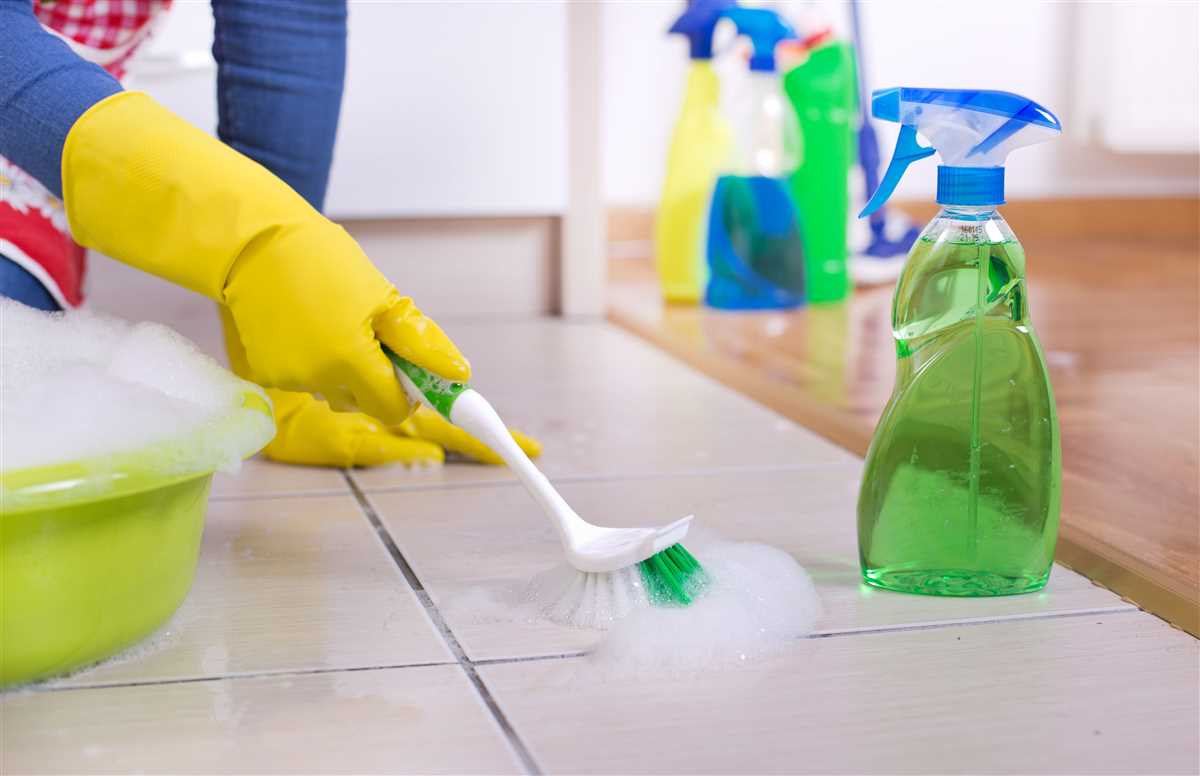
After mopping, it’s essential to dry the floor completely to prevent any water spots or streaks from forming. Use a clean, dry cloth or a mop with a microfiber pad to remove any excess moisture.
7. Use Mats or Rugs
To minimize the amount of dirt and spills reaching your tiled kitchen floor, place mats or rugs in high traffic areas, such as near the sink or stove. These mats will help trap dirt and catch any spills, making it easier to keep your floor clean.
By following these effective cleaning tips, you can maintain the cleanliness and shine of your tiled kitchen floors for years to come.
Quick and Easy Tile Cleaning Techniques
1. Sweep or Vacuum the Floor
Before you start cleaning your tiled kitchen floor, it’s important to remove any loose dirt and debris. Use a broom or vacuum cleaner to sweep or vacuum the entire floor surface.
2. Prepare a Cleaning Solution
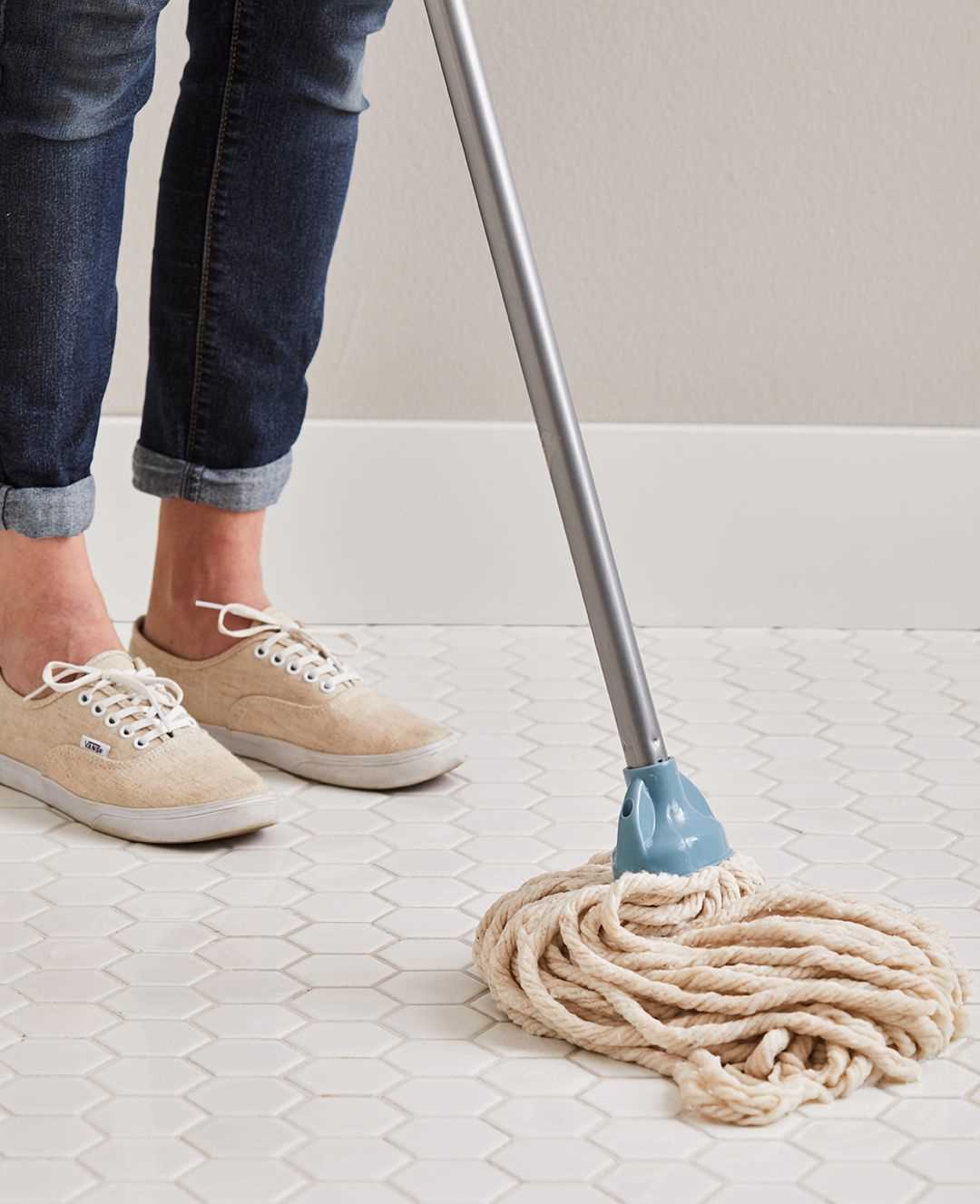
Mix a solution of warm water and mild dish soap in a bucket. The soap will help break down any greasy or sticky residue on the tiles.
Note: Avoid using harsh cleaning chemicals on your tiled floor, as they can damage the surface or grout.
3. Mop the Floor
Dip a mop into the cleaning solution and wring it out until it’s damp, not soaking wet. Start mopping the tiled floor, working in small sections at a time.
Pro Tip: For tougher stains or grime, allow the cleaning solution to sit on the tiles for a few minutes before mopping.
4. Pay Attention to Grout Lines
The grout lines between your tiles can easily accumulate dirt and stains. Use a soft brush or an old toothbrush to scrub the grout lines gently. Focus on any discolored areas and be thorough in your cleaning.
5. Rinse the Floor
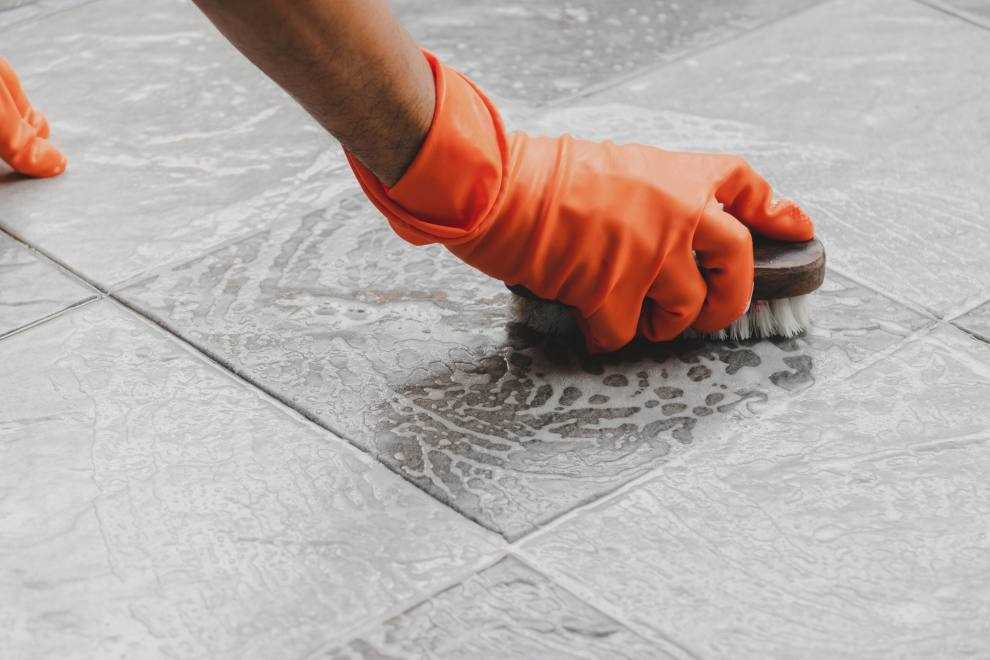
After mopping and scrubbing, rinse the mop or a clean sponge in clean water and go over the floor again to remove any remaining soap residue.
6. Dry the Floor
Allow the floor to air dry or use a clean towel or mop to speed up the drying process. Ensure the floor is completely dry before walking on it to prevent slips or falls.
7. Maintain Regular Cleaning
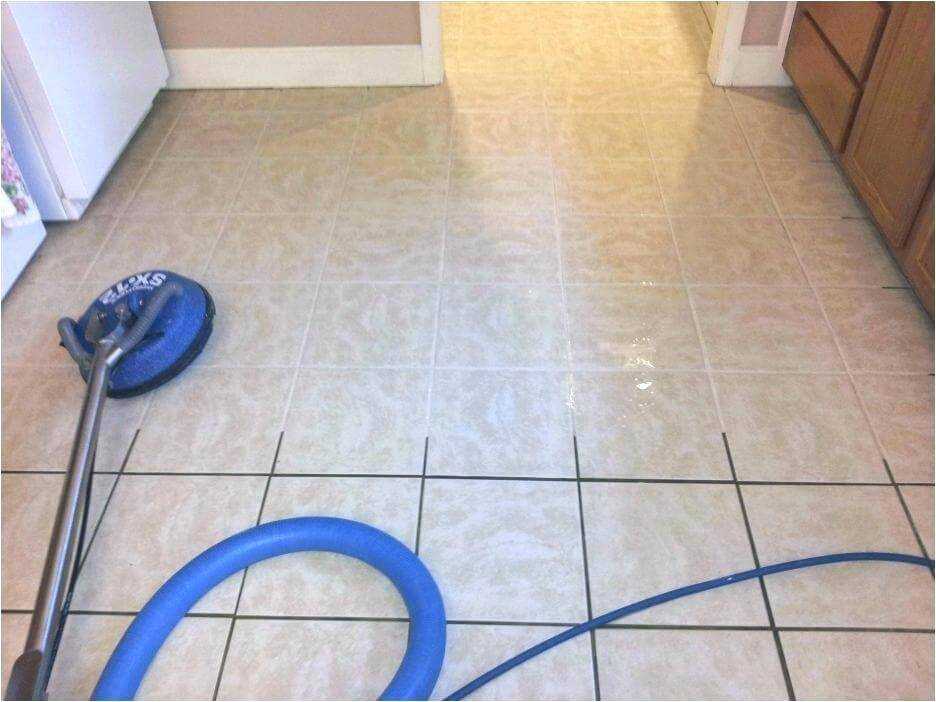
To keep your tiled kitchen floor looking its best, make it a habit to sweep or vacuum regularly to remove dirt and debris. Also, consider mopping with a diluted cleaning solution at least once a week to maintain its shine and cleanliness.
By following these quick and easy tile cleaning techniques, you can keep your kitchen floor looking clean and fresh without much effort.
Essential Tools and Products for Cleaning
When it comes to cleaning your tiled kitchen floor, having the right tools and products can make the task much easier and more effective. Here are some essential items you’ll need:
1. Broom or Vacuum
Before you start cleaning, it’s important to sweep or vacuum the floor to remove any loose dirt and debris. Use a broom with stiff bristles or a vacuum cleaner with a floor attachment to thoroughly clean the surface.
2. Microfiber Mop
A microfiber mop is ideal for cleaning tiled floors as it is gentle yet effective at removing dirt and grime. The microfiber material can attract and trap dust and particles, leaving your floor clean and shiny. Look for a mop with a washable and reusable microfiber head for convenience and cost-effectiveness.
3. Bucket

A bucket is essential for mixing cleaning solutions and providing a convenient container for carrying water. It’s best to choose a bucket with a handle for easy transportation and a stable base to prevent spills.
4. Cleaning Solution
There are several cleaning solutions available on the market specifically designed for tiled floors. Look for a pH-neutral cleaner that is safe for use on tiles and won’t leave any residue or streaks. Alternatively, you can make your own cleaning solution using a mixture of warm water and mild dish soap.
5. Scrub Brush
A scrub brush with stiff bristles can be helpful for removing tough stains and grout lines. Choose a brush with an ergonomic handle for comfortable grip and control.
6. Grout Cleaner
If your grout lines are looking dirty or discolored, you may need a grout cleaner to restore their original color. Look for a grout cleaner that is safe for use on your specific type of tiles and follow the instructions carefully.
7. Microfiber Cloths
Microfiber cloths are great for drying and buffing your tiled floor after cleaning. They are lint-free and absorbent, leaving your tiles streak-free and shiny.
8. Protective Gloves
When using cleaning products, it’s important to protect your hands with gloves. Choose gloves that are made of a durable and chemical-resistant material for maximum protection.
9. Knee Pads
Cleaning tiled floors can be a physically demanding task, especially when scrubbing grout lines or getting into low areas. Knee pads can provide cushioning and support, reducing strain on your knees and making the job more comfortable.
By having these essential tools and products on hand, you’ll be well-equipped to tackle the task of cleaning your tiled kitchen floor effectively and efficiently.
Step-by-Step Guide for Deep Cleaning
Deep cleaning your tiled kitchen floor can help remove stubborn stains and grime, leaving it looking fresh and new. Follow these step-by-step instructions to achieve a sparkling clean kitchen floor.
1. Gather Your Supplies
Before starting the deep cleaning process, gather all the necessary supplies. You will need:
- Broom or vacuum cleaner
- Mop
- Bucket
- Hot water
- Mild detergent or floor cleaner
- Scrub brush or sponge
- Old towels or cloths
2. Remove Loose Debris
Begin by sweeping or vacuuming the floor to remove any loose dirt, dust, or debris. Pay special attention to corners and hard-to-reach areas.
3. Prepare the Cleaning Solution
Fill a bucket with hot water and add a small amount of mild detergent or floor cleaner. Follow the manufacturer’s instructions regarding the appropriate amount to use.
4. Pre-Treat Stains
If you have any stubborn stains on your tiles, apply a small amount of the cleaning solution directly onto the stain. Let it sit for a few minutes to loosen the stain before scrubbing.
5. Scrub the Floor

Dip your mop or scrub brush into the cleaning solution and start scrubbing the floor. Work in small sections, applying pressure to remove any dirt or grime. Pay extra attention to high-traffic areas.
6. Rinse and Repeat
Once you have scrubbed the entire floor, rinse the mop or scrub brush with clean water and go over the floor again to remove any remaining dirt or residue.
7. Dry the Floor
Use old towels or cloths to dry the floor thoroughly. This will prevent water spots and ensure a clean, shiny finish.
8. Optional: Apply a Sealant
If your tiled floor is particularly porous or prone to staining, you may consider applying a sealant to protect it. Follow the manufacturer’s instructions for the specific sealant you are using.
9. Maintain Regular Cleaning
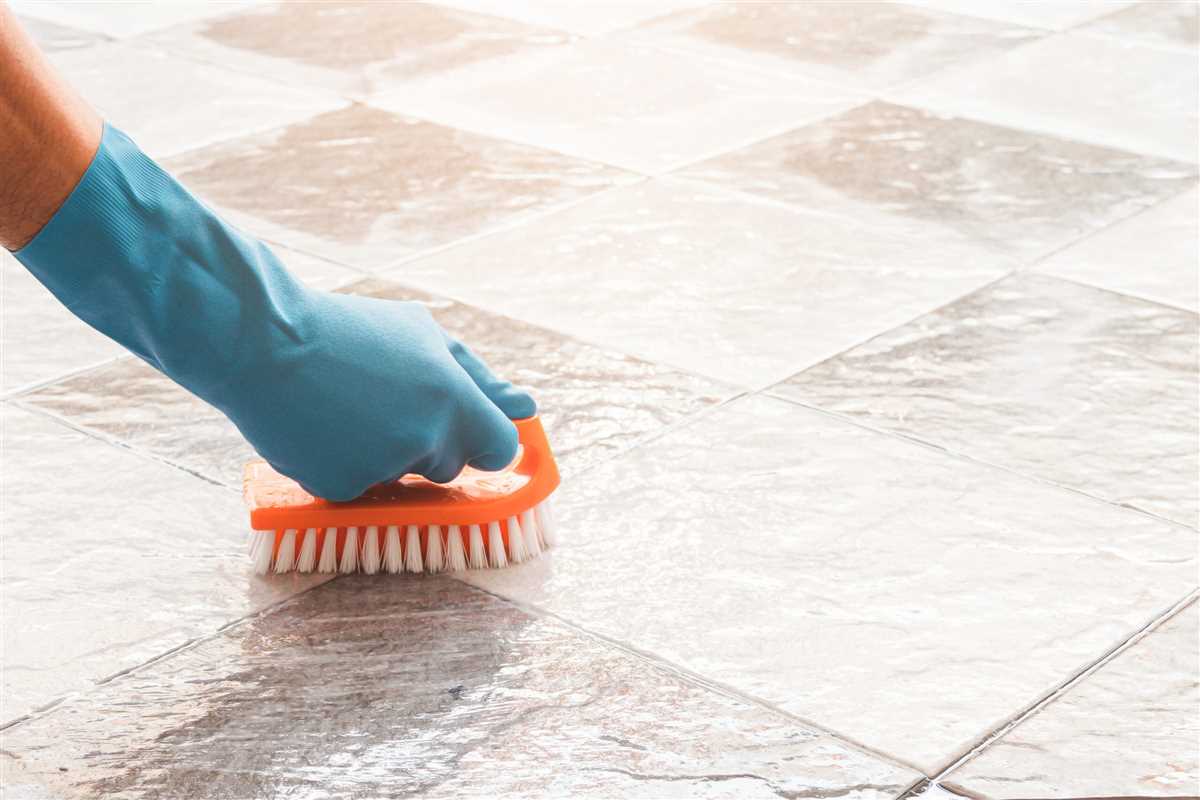
To keep your tiled kitchen floor looking its best, make sure to maintain regular cleaning. Sweep or vacuum daily, and mop with a mild cleaning solution as needed.
By following this step-by-step guide, you can deep clean your tiled kitchen floor effectively and easily. Enjoy the beauty of a fresh and sparkling floor!
Natural and Environmentally Friendly Cleaning Solutions
When it comes to cleaning your tiled kitchen floor, using natural and environmentally friendly cleaning solutions is not only good for the planet, but also for your health. Many commercial cleaning products contain harsh chemicals that can be harmful when inhaled or come into contact with your skin. By opting for natural cleaning solutions, you can ensure that your kitchen floor stays clean and safe.
Vinegar and Water
Vinegar is a natural cleaning agent that is effective at removing dirt and grime from tiled floors. To create a cleaning solution, simply mix equal parts vinegar and water in a spray bottle. Spray the solution onto your tiled floor and let it sit for a few minutes. Then, use a damp mop to clean the floor, making sure to rinse the mop regularly in clean water. Vinegar not only cleans the floor, but it also helps to remove odors.
Baking Soda and Water
Baking soda is another natural cleaning solution that can effectively remove stains and grease from tiled floors. To create a paste, mix baking soda with water until it forms a thick consistency. Apply the paste to the stained or dirty areas of your floor and let it sit for about 15 minutes. Then, scrub the area with a brush or sponge and rinse it off with clean water. Baking soda is gentle enough to use on all types of tiled floors without causing damage.
Lemon Juice and Water
Lemon juice is an excellent natural cleaning solution for tackling tough stains and leaving your kitchen smelling fresh. Mix equal parts lemon juice and water in a spray bottle and apply the solution to the stained areas of your tiled floor. Let it sit for a few minutes, then scrub the stains with a brush or sponge. Lemon juice not only cleans the floor, but it also adds a pleasant citrus scent.
Steam Cleaning
Steam cleaning is an environmentally friendly and effective way to deep clean your tiled kitchen floor without the use of chemicals. Steam cleaners use high-temperature steam to break down dirt and grime, leaving your floor spotless. Simply fill the steam cleaner with water, wait for it to heat up, and then run it over your tiled floor. The steam will loosen the dirt and grime, which can then be easily wiped away with a mop or cloth.
Tips for Using Natural Cleaning Solutions:
- Always test the cleaning solution on a small, inconspicuous area of your tiled floor before using it on the entire floor.
- Be sure to read the manufacturer’s instructions for any cleaning tools or devices you plan to use.
- Regularly sweep or vacuum your tiled floor to remove loose dirt and debris before using any cleaning solution.
- Consider wearing gloves and protective clothing when using natural cleaning solutions to protect your hands and skin.
- Open windows or use a fan to ensure proper ventilation while using cleaning solutions.
By using these natural and environmentally friendly cleaning solutions, you can keep your tiled kitchen floor clean and safe while also minimizing your impact on the environment.
Maintenance Tips to Keep Your Tiled Floor Clean
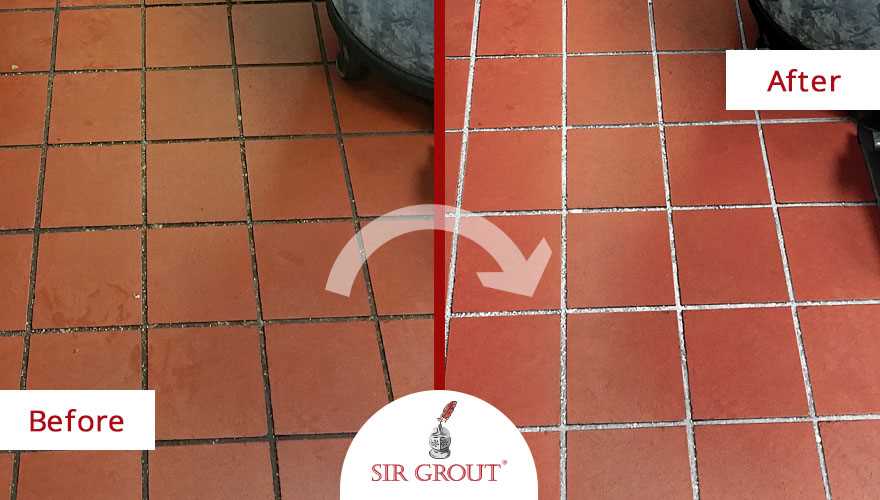
Regular Sweeping and Vacuuming
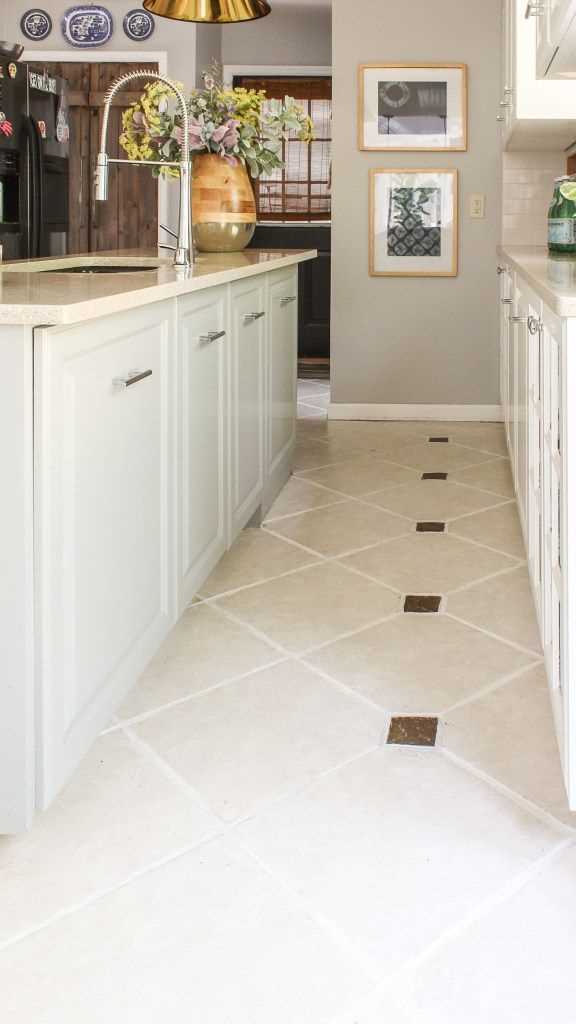
One of the best ways to keep your tiled floor clean is to sweep or vacuum it regularly. This will help remove any loose dirt, debris, or crumbs that can accumulate on the surface. It’s important to use a soft-bristle broom or a vacuum cleaner with a brush attachment to avoid scratching the tiles.
Mopping with Warm Water and Mild Detergent
To maintain the cleanliness of your tiled floor, you should mop it with warm water and a mild detergent on a weekly basis. Mix a small amount of detergent with warm water in a bucket and use a mop or a microfiber cloth to clean the tiles. Avoid using excessive water, as it can seep into the grout lines and cause damage over time.
Removing Stains Promptly
If you notice any stains on your tiled floor, it’s important to remove them promptly to prevent them from becoming permanent. Use a mild cleaning solution specifically designed for tiles and follow the instructions on the product label. Avoid using harsh chemicals or abrasive cleaners, as they can damage the tiles.
Protecting the Grout Lines
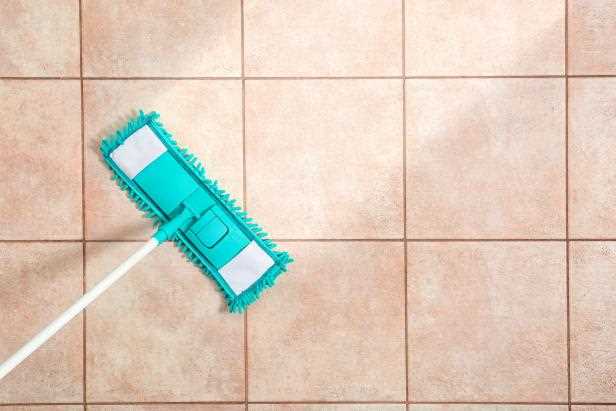
The grout lines between the tiles are vulnerable to dirt and stains. To keep them clean and in good condition, you can apply a grout sealer once every six months. This will help protect the grout from absorbing moisture and becoming discolored. Additionally, avoid dragging heavy furniture or sharp objects across the tiled floor, as they can damage the grout lines.
Using Doormats and Rugs
Placing doormats at the entrances to your kitchen can help reduce the amount of dirt and debris that gets tracked onto your tiled floor. Make sure to clean the doormat regularly to prevent it from becoming a source of dirt itself. You can also consider using rugs in high-traffic areas to protect the tiles from wear and tear.
Regular Inspections
Periodically inspect your tiled floor for any signs of damage, such as cracked or chipped tiles. If you notice any issues, it’s important to address them as soon as possible to prevent further damage. Contact a professional tile installer or a maintenance specialist for proper repairs and guidance.
Conclusion
Maintaining a clean tiled floor requires regular sweeping, mopping, stain removal, and grout protection. By following these maintenance tips, you can keep your tiled kitchen floor looking beautiful and prolong its lifespan. Remember, proper care and attention will go a long way in preserving the integrity and appearance of your tiled floor.
FAQ
What is the best way to clean a tiled kitchen floor?
The best way to clean a tiled kitchen floor is to start by sweeping or vacuuming to remove any loose dirt or debris. Then, mix a solution of warm water and mild detergent. Use a mop or microfiber cloth to clean the floor, making sure to wring out excess water to avoid soaking the tiles. Rinse the floor with clean water and dry it thoroughly.
Can I use vinegar to clean my tiled kitchen floor?
Yes, vinegar can be used to clean a tiled kitchen floor. You can mix equal parts of vinegar and water to create a cleaning solution. However, it is important to note that vinegar is acidic and may damage certain types of tiles, such as natural stone. It is always recommended to test the solution on a small, inconspicuous area of the floor before using it on the entire surface.
How often should I clean my tiled kitchen floor?
It is recommended to clean a tiled kitchen floor at least once a week. However, if the floor experiences heavy traffic or gets dirty frequently, it may need to be cleaned more often. Regular cleaning helps to maintain the appearance of the tiles and prevent the buildup of dirt and grime.
Is it necessary to use a specific type of mop for cleaning a tiled kitchen floor?
There is no specific type of mop that is necessary for cleaning a tiled kitchen floor. However, it is best to use a mop with a microfiber head or a sponge mop. These types of mops are gentle on the tiles and effectively remove dirt and stains. Avoid using mops with rough or abrasive surfaces, as they may scratch or damage the tiles.
Can I use bleach to clean my tiled kitchen floor?
Bleach can be used to clean a tiled kitchen floor, but it should be used with caution. It is important to dilute the bleach with water according to the manufacturer’s instructions. Additionally, bleach should not be used on certain types of tiles, such as natural stone, as it may cause discoloration or damage. Always test the bleach solution on a small, inconspicuous area before using it on the entire floor.
What should I do if there are stains on my tiled kitchen floor?
If there are stains on your tiled kitchen floor, you can try using a specialized tile cleaner or a homemade cleaning solution. For greasy stains, you can use a mixture of warm water and dish soap. Apply the solution to the stain, let it sit for a few minutes, and then scrub the area gently with a soft brush or sponge. Rinse the floor with clean water and dry it thoroughly.
Are there any tips for maintaining the cleanliness of a tiled kitchen floor?
Yes, there are several tips for maintaining the cleanliness of a tiled kitchen floor. First, it is important to sweep or vacuum the floor regularly to remove loose dirt and debris. Second, place mats or rugs at the entrances of the kitchen to help prevent dirt and moisture from being tracked onto the floor. Third, wipe up spills and stains immediately to prevent them from becoming difficult to remove. Finally, avoid using harsh or abrasive cleaners that can damage the tiles.














